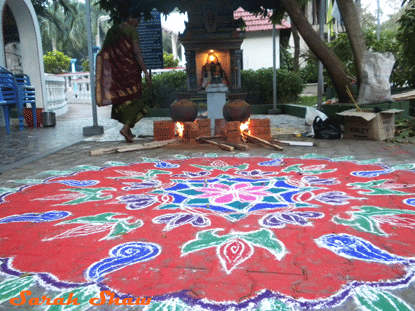 While on a WanderTours trip to Southern India a couple years ago, I discovered the holiday of Pongal. Taking place in January, it is a harvest festival like our American Thanksgiving and has been celebrated for more than a thousand years. It is an extremely important holiday for people in Tamil Nadu, the southeastern state in India, and the country of Sri Lanka although you may also find it celebrated where people from these areas have immigrated. People enjoy Pongal throughout India but it does seem to be most important to the people of Tamil Nadu. It is a four day festival celebrated on our calendar days of January 13-16 each year. During the holiday, Tamils thank the Sun God, Surya, for a good harvest in hopes of continued success.
While on a WanderTours trip to Southern India a couple years ago, I discovered the holiday of Pongal. Taking place in January, it is a harvest festival like our American Thanksgiving and has been celebrated for more than a thousand years. It is an extremely important holiday for people in Tamil Nadu, the southeastern state in India, and the country of Sri Lanka although you may also find it celebrated where people from these areas have immigrated. People enjoy Pongal throughout India but it does seem to be most important to the people of Tamil Nadu. It is a four day festival celebrated on our calendar days of January 13-16 each year. During the holiday, Tamils thank the Sun God, Surya, for a good harvest in hopes of continued success.
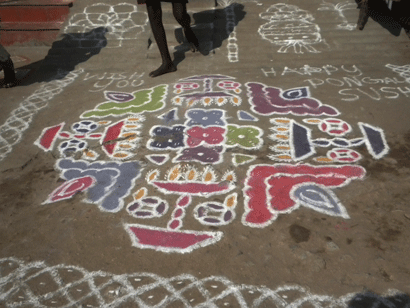 One of the first things foreigners ice about the holiday is the abundance of kolam everywhere. Kolam are geometric designs created each morning in front of the door to a home or business. They are drawn out using rice flour and then are usually filled in with colored flour for the festival. Kolam begin appearing a month in advance of Pongal and welcome and bless visitors who pass over them. Every morning the woman of the house would begin her day by cleaning the area in front of the door. Then the outline is sketched followed by the color and greeting, if desired. Each day a new design is installed. As I stopped by shops, I regularly saw women sketching out kolam designs in notebooks for future mornings. Many begin with a dot grid and then create the complicated designs from there. One of my favorite souvenirs from this trip was a set of kolam design books I was able to purchase for less than 50 cents in total. Some women require inspiration! At the end of this post, I will share a sequence of photos that show the creation of a kolam outside my hotel in Pondicherry.
One of the first things foreigners ice about the holiday is the abundance of kolam everywhere. Kolam are geometric designs created each morning in front of the door to a home or business. They are drawn out using rice flour and then are usually filled in with colored flour for the festival. Kolam begin appearing a month in advance of Pongal and welcome and bless visitors who pass over them. Every morning the woman of the house would begin her day by cleaning the area in front of the door. Then the outline is sketched followed by the color and greeting, if desired. Each day a new design is installed. As I stopped by shops, I regularly saw women sketching out kolam designs in notebooks for future mornings. Many begin with a dot grid and then create the complicated designs from there. One of my favorite souvenirs from this trip was a set of kolam design books I was able to purchase for less than 50 cents in total. Some women require inspiration! At the end of this post, I will share a sequence of photos that show the creation of a kolam outside my hotel in Pondicherry.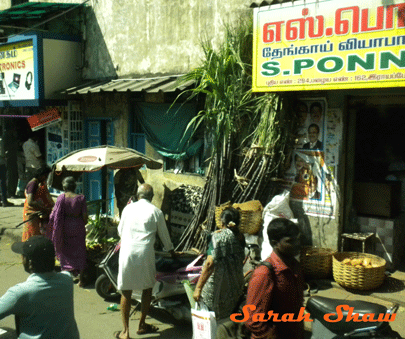
The word pongal means “boiling over” in the Tamil language and refers to the dish of the same name as the holiday. At meals during the festival, I came across both sweet and savory dishes of pongal being served. The sweet version is made with rice, lentils, milk, sugar, cardamom, raisins and cashews. The savory version again has rice and lentils and is salty. Traditionally, pongal would be served on banana leaves. In celebration of the holiday, pongal is made out in the courtyard in a clay pot over a fire and the area is decorated with kolam. When the milk reaches a boil and oveflows the pot, people shout “Pongalo Pongal.” Seeing the pot boil over is considered to be very lucky and will bring prosperity in the next year. The first day of the festival is called Bhogi Pongal and people worship the rain god and the earth and make pongal from their first rice harvest grain.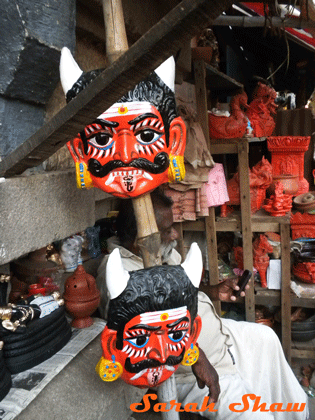
On the second day, known as Surya Pongal, the holiday is celebrated by people clearing out old things from their home and preparing for the new. The house is given a thorough cleaning and old clothes are given away or burned in the traditional bonfire. celebratory oil massage is in order and people put on new clothes they have purchase for the day. It is also the most important day of the festival as people worship the sun god Surya and his consorts Chaya and Samgnya. Above are images for sale in at a temple market. They are hung on homes and business to scare off evil. On this day, people will destroy their old protectors and hang new ones fresh for the new year.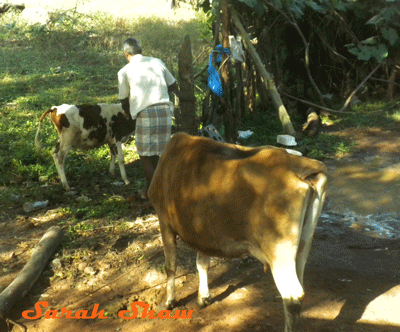
The third day is called Mattu Pongal and the livestock are also collected, cleansed and decorated to share in the Pongal festivities. Their horns may be painted different colors and their necks decorated with garlands. It was fun to come across the cows everywhere sporting their decorations. I found them wandering about the streets in search of food as well as in the temples. The animals are also fed pongal as a special treat for the holiday as they are an important part of the harvest having helped to plow the fields and given their milk. Above a man washes his cows near Auroville in Tamil Nadu. Below is a cow already decorated I came across while wandering a temple.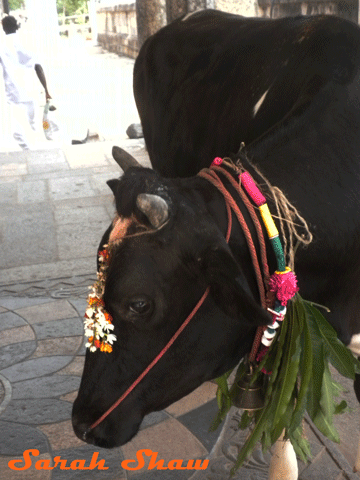
The final day of the festivities is Kaanum Pongal. It is marked by families gathering together. Women perform a puja, or prayer, for their brothers. Their brothers in return present their married sisters with gifts to demonstrate their love. Older family members give presents to younger ones. It is common for families to go to beaches, parks and temples and enjoy their day together with picnics. Sugar cane is traditionally chewed. From the time I arrived in Chennai, I began to see stalks of black sugar cane for sale. It is used as part of the decorations next to the door to a home or alongside an altar. Friends may also be included in the gatherings as the purpose is to thank everyone for their help in the harvest this year. The photo below is of a teenage girl with flowers decorating her hair and braid. She is wearing new clothes to celebrate Pongal. She and her family have gathered on the lawn of a local temple for a holiday picnic and she was pleased that I wanted to photograph her. 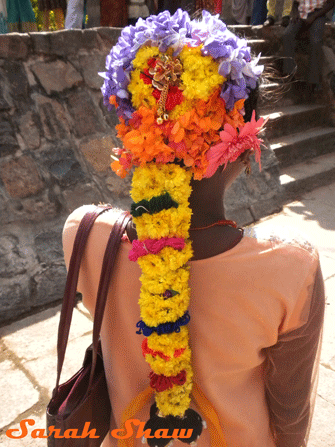
While traveling through the countryside of Tamil Nadu, we came across a rural Pongal celebration. We witnessed a procession of a tractor pulling a wagon carrying a decorated image of (I’m guessing) Surya, the sun god. People gathered on both sides of the street, cheering and celebrating. Many of the men and boys carried buffalo-hide drums and beat them in celebration. It was a lot of fun to be part of the excitement and everyone was in a good mood and wanted to share their traditions with us. 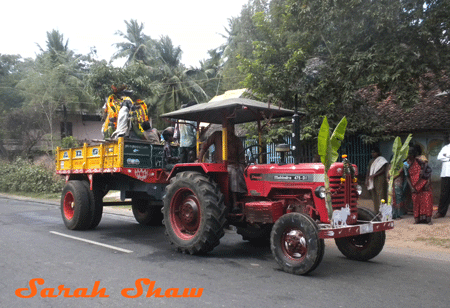
Later, we passed through this same village and all the people had gathered for some traditional games. One was very much like the Mexican pinatas you were used to at birthday parties. A clay pot is filled and is suspended up high in the air. A boy is selected, blindfolded and handed a long stick. He then is to try to break the pot. The boy we saw must have been either really good or really inspired as he hit and broke the pot on his first try!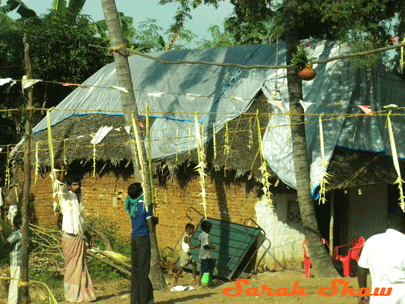
As promised, here is a sequence of photographs that show how a kolam is made. This one was created for the guests of the hotel I stayed at in Pondicherry. First the area for the kolam is washed. Then the design begins by being drawn with white rice flour, starting with the center first and working its way out.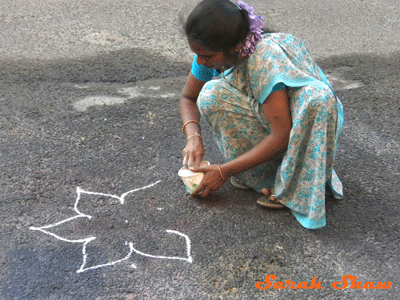
As the design takes shape, another woman joins in by adding some color within the outlines. The color is created by adding powdered dye to the rice flour and mixing it together. As one woman adds color, the other continues to add details to the design in white.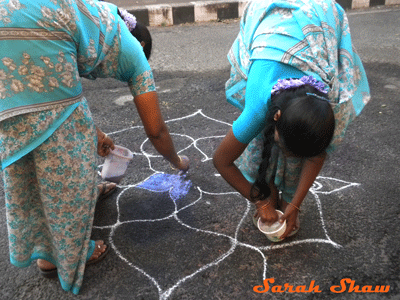
The design has become larger and more elaborate with swirls added to white outline. The women are very accomplished and work quickly. They have surely been creating kolam for many years both at home and at the hotel.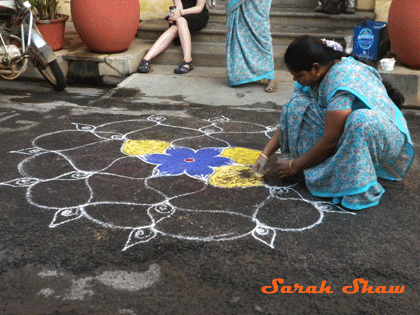
Even more colors are added to the design which is really begining to pop against the light at dusk. Usually kolam are created first thing in the morning but I think this one was being created in the evening in advance of dinner service at the hotel when many tourists would be arriving. I was glad it was created later as it allowed me so watch the step involved and photograph it for sharing with you.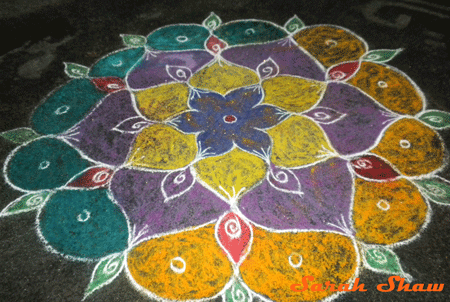
At last, the kolam is completed. I loved the metallic accents in the center of the flower. In person, they really flickered in the light of the evening.
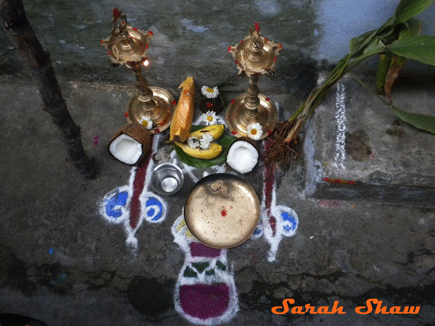 Above is an altar outside a home in Tamil Nadu. The kolam includes a Pongal drum and represntation of black sugar cane. The plant is also present on the left of the altar. Other offerings include bananas, coconuts, water and flowers. Oil lamps of brass flank both sides.
Above is an altar outside a home in Tamil Nadu. The kolam includes a Pongal drum and represntation of black sugar cane. The plant is also present on the left of the altar. Other offerings include bananas, coconuts, water and flowers. Oil lamps of brass flank both sides.
I recommend that when you are traveling in another country and discover a holiday being celebrated, that you purchase a souvenir to remember it by when you are back home. As I mentioned above, I bought a couple of books showing kolam designs which look much like coloring books. I used these last summer for my neighborhood block party. Each house was supposed to have an activity for kids and adults to enjoy. I made copies of some of the pages and bought some sidewalk chalk. I had those out on my sidewalk so people could try to create the design of their choice. The women of Tamil Nadu make this look so easy but I can tell you it is hard to create nice designs! It was a fun way to share some of my travels with my neighbors.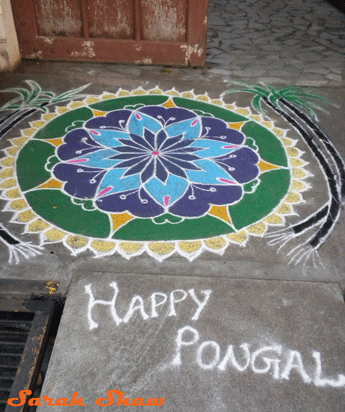
If you wish to see more images from Pongal celebrations in Tamil Nadu, please visit WanderShopper’s Facebook fanpage where the India photo album will have more photos from this amazing holiday. Be sure to “like” the fanpage while you are there so you learn about upcoming posts and are alerted to Facebook only content. Happy Pongal, everyone!